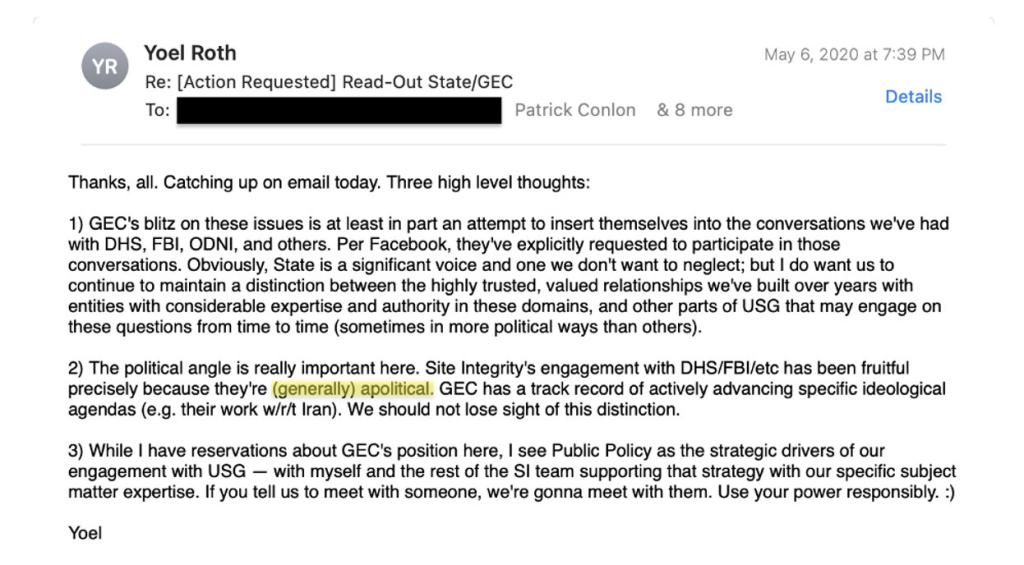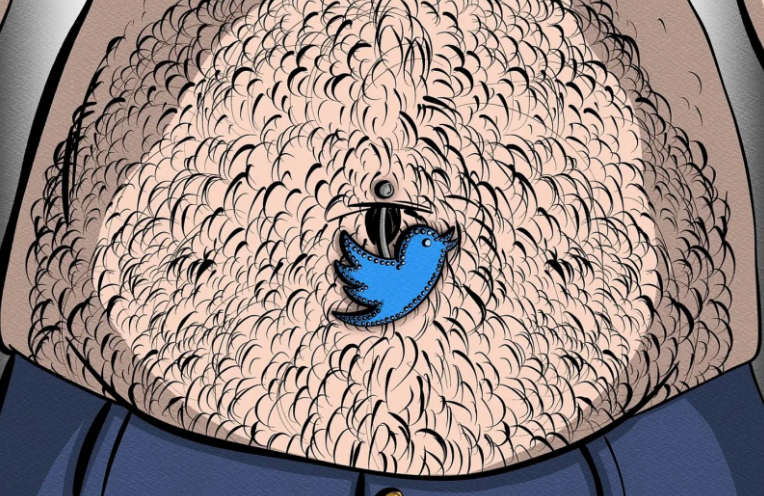The latest installment of the Twitter Files revealed the FBI’s desire for Twitter to rely on it to be the belly button of the U.S. government (USG). The first Twitter Files installment of 2023 revealed shared the events that led up to the intelligence community’s influence on Twitter. Following that installment, journalist Matt Taibbi released another, which revealed the Global Engagement Center’s (GEC) role.
Taibbi described the GEC as “a fledgling analytic/intelligence arms of the State Department,” and screenshots revealed how this new entity would go directly to the media. In one such instance, a report titled, Russian Disinformation Apparatus Taking Advantage of Coronavirus Concerns, was released, which wrecked a bit of havoc for Twitter.
1.THREAD: The Twitter Files
Twitter and the FBI “Belly Button” pic.twitter.com/nfOGQGlvUM— Matt Taibbi (@mtaibbi) January 3, 2023
Twitter’s then Trust and Safety head, Yoel Roth, pointed out the motives of Clemson’s Media Forensic Hub when it complained that Twitter hadn’t “made a Russia attribution” in some time.

Credit: Matt Taibbi

Credit: Matt Taibbi
Roth told researchers like Clemson that Twitter would be happy to work directly with them instead of the media. He was unsuccessful. Simultaneously, Twitter was trying to reduce the number of agencies that had access to Roth. Twitter’s then-policy director, Carlos Monje, pointed out that once Twitter gave these agencies, such as the Department of Homeland Security, access to Roth.
“If these folks are like House Homeland Committee and DHS, once we give them direct contact with Yoel, they will want to come back to him again and again,” Monje said.
Taibbi noted that the GEC report appeared to be based on DHS data that was circulated earlier that week. The data included accounts that followed two or more Chinese diplomatic accounts and ended up with a list “nearly 250,000” names long. The list included Canadian officials and a CNN account.

Credit: Matt Taibbi
In an email, Roth said that the GEC attempted to insert itself into conversations Twitter had with several government agencies, including the FBI and DHS. The GEC began to agree to loop Twitter in before going public; however, the agency used a technique that trapped Twitter previously.
“The delta between when they share material and when they go to the press continues to be problematic,” a comms official wrote, adding that they primed the media to be “curios and inquisitive of this dynamic, too.”

Credit: Matt Taibbi
This led to Twitter’s disputing a State Department claim that China coordinated coronavirus disinformation accounts. The FBI then informed Twitter that the GEC wanted to be included in their regular “industry call” between companies like Twitter and Facebook and the DHS and FBI. At first, Twitter didn’t want to go this route. Executives at Facebook and Google were united with Twitter in its opposition to the GEC’s inclusion.
“The GEC’s mandate for offensive IO to promote American interests. The relative lack of discretion and caution from senior GEC leadership in sharing reports/analysis based on shaky methodology. A limited track record of successful collaboration with industry.”
Roth noted that an actor such as GEC being introduced to a stable and trusted group of practitioners and experts, especially with the election heating up, posed major risks.

Credit: Matt Taibbi
Roth added that another reason was that the DHS and FBI were “apolitical,” whereas the GEC was “political.”
“GEC has a track record of actively advancing specific ideological agendas (e.g., their work w/r/t Iran). We should not lose sight of this distinction,” Roth wrote.

Credit: Matt Taibbi
The FBI argued for a compromise solution that would allow other U.S. government (USG) agencies to participate in the industry calls, with the FBI and DHS acting as sole conduits. When Roth reached out to FBI agent Elvis Chan with concerns, Chan reassured the Twitter executive that it would be a “one-way” channel and “State/GEC, NSA, and CIA have expressed interest in being allowed on in listen mode only.”
“We can give you everything we’re seeing from the FBI and USIC agencies,” Chan told Roth, adding that the DHS agency Cybersecurity and Infrastructure Security Agency (CISA) “will know what’s going on in each state.” Chan then asked if the industry could “rely on the FBI to be the belly button of the USG.”

Credit: Matt Taibbi
The group eventually chose Signal due to its operational security. Following that, Twitter began taking requests from various government bodies starting with the Senate Intel Committee (SSCI), which needed reassurance that Twitter was taking FBI direction.
Twitter also received various requests from officials wanting individuals they didn’t like to be banned from the platform. In the screenshot below, the office for Democrat and House Intel Committee chief Adam Schiff asked Twitter to ban journalist Paul Sperry.

Credit: Matt Taibbi
At the time, Twitter refused. However, Sperry was later suspended. “No, this isn’t feasible/we don’t do this,” Twitter replied.

Twitter honored many of the requests, including those from the GEC, to ban accounts the GEC identified as “GRU-controlled” and linked “to the Russian government.”
A former CIA staffer working at Twitter called the GEC requests “Our window on that is closing,” which meant that the days Twitter could say no to serious requests were over. In the Twitter Files that were released earlier today, Taibbi noted that in public, Twitter would remove content at its “sole discretion.”
Privately, the platform would “off-board” anything that was “identified by the U.S. intelligence community as state-sponsored entity conducting cyber-operations.” That was in 2017. By 2020, agencies were flooding Twitter with “identifications” or users that it wanted Twitter to remove.

Credit: Matt Taibbi
Taibbi pointed out that some reports were only a paragraph long and that Twitter would be forwarded an Excel document without further explanation. Twitter was also warned about the publicity surrounding a book written by former Ukraine prosecutor Viktor Shokhin, who alleged “corruption by the U.S. government” – specifically by Joe Biden.
Screenshots reveal that by mere weeks before the 2020 election, Twitter was so confused by the multiple streams of incoming requests that staffers had to ask the FBI which was which.

Credit: Matt Taibbi
Taibbi noted that this led to the situation described in an earlier Twitter Files release by Michael Shellenberger on December 19, 2022.
In that release, it was revealed that Twitter was paid $3,415,323. Taibbi noted that Twitter wasn’t just paid but underpaid for the amount of work it did for the government.
Your feedback is welcome. If you have any comments or concerns or see a typo, you can email me at johnna@teslarati.com. You can also reach me on Twitter at @JohnnaCrider1.
Teslarati is now on TikTok. Follow us for interactive news & more. Teslarati is now on TikTok. Follow us for interactive news & more. You can also follow Teslarati on LinkedIn, Twitter, Instagram, and Facebook.
News
Tesla cleared in Canada EV rebate investigation
Tesla has been cleared in an investigation into the company’s staggering number of EV rebate claims in Canada in January.

Canadian officials have cleared Tesla following an investigation into a large number of claims submitted to the country’s electric vehicle (EV) rebates earlier this year.
Transport Canada has ruled that there was no evidence of fraud after Tesla submitted 8,653 EV rebate claims for the country’s Incentives for Zero-Emission Vehicles (iZEV) program, as detailed in a report on Friday from The Globe and Mail. Despite the huge number of claims, Canadian authorities have found that the figure represented vehicles that had been delivered prior to the submission deadline for the program.
According to Transport Minister Chrystia Freeland, the claims “were determined to legitimately represent cars sold before January 12,” which was the final day for OEMs to submit these claims before the government suspended the program.
Upon initial reporting of the Tesla claims submitted in January, it was estimated that they were valued at around $43 million. In March, Freeland and Transport Canada opened the investigation into Tesla, noting that they would be freezing the rebate payments until the claims were found to be valid.
READ MORE ON ELECTRIC VEHICLES: EVs getting cleaner more quickly than expected in Europe: study
Huw Williams, Canadian Automobile Dealers Association Public Affairs Director, accepted the results of the investigation, while also questioning how Tesla knew to submit the claims that weekend, just before the program ran out.
“I think there’s a larger question as to how Tesla knew to run those through on that weekend,” Williams said. “It doesn’t appear to me that we have an investigation into any communication between Transport Canada and Tesla, between officials who may have shared information inappropriately.”
Tesla sales have been down in Canada for the first half of this year, amidst turmoil between the country and the Trump administration’s tariffs. Although Elon Musk has since stepped back from his role with the administration, a number of companies and officials in Canada were calling for a boycott of Tesla’s vehicles earlier this year, due in part to his association with Trump.
News
Tesla Semis to get 18 new Megachargers at this PepsiCo plant
PepsiCo is set to add more Tesla Semi Megachargers, this time at a facility in North Carolina.

Tesla partner PepsiCo is set to build new Semi charging stations at one of its manufacturing sites, as revealed in new permitting plans shared this week.
On Friday, Tesla charging station scout MarcoRP shared plans on X for 18 Semi Megacharging stalls at PepsiCo’s facility in Charlotte, North Carolina, coming as the latest update plans for the company’s increasingly electrified fleet. The stalls are set to be built side by side, along with three Tesla Megapack grid-scale battery systems.
The plans also note the faster charging speeds for the chargers, which can charge the Class 8 Semi at speeds of up to 1MW. Tesla says that the speed can charge the Semi back to roughly 70 percent in around 30 minutes.
You can see the site plans for the PepsiCo North Carolina Megacharger below.

Credit: PepsiCo (via MarcoRPi1 on X)

Credit: PepsiCo (via MarcoRPi1 on X)
READ MORE ON THE TESLA SEMI: Tesla to build Semi Megacharger station in Southern California
PepsiCo’s Tesla Semi fleet, other Megachargers, and initial tests and deliveries
PepsiCo was the first external customer to take delivery of Tesla’s Semis back in 2023, starting with just an initial order of 15. Since then, the company has continued to expand the fleet, recently taking delivery of an additional 50 units in California. The PepsiCo fleet was up to around 86 units as of last year, according to statements from Semi Senior Manager Dan Priestley.
Additionally, the company has similar Megachargers at its facilities in Modesto, Sacramento, and Fresno, California, and Tesla also submitted plans for approval to build 12 new Megacharging stalls in Los Angeles County.
Over the past couple of years, Tesla has also been delivering the electric Class 8 units to a number of other companies for pilot programs, and Priestley shared some results from PepsiCo’s initial Semi tests last year. Notably, the executive spoke with a handful of PepsiCo workers who said they really liked the Semi and wouldn’t plan on going back to diesel trucks.
The company is also nearing completion of a higher-volume Semi plant at its Gigafactory in Nevada, which is expected to eventually have an annual production capacity of 50,000 Semi units.
Tesla executive teases plan to further electrify supply chain
News
Tesla sales soar in Norway with new Model Y leading the charge
Tesla recorded a 54% year-over-year jump in new vehicle registrations in June.

Tesla is seeing strong momentum in Norway, with sales of the new Model Y helping the company maintain dominance in one of the world’s most electric vehicle-friendly markets.
Model Y upgrades and consumer preferences
According to the Norwegian Road Federation (OFV), Tesla recorded a 54% year-over-year jump in new vehicle registrations in June. The Model Y led the charge, posting a 115% increase compared to the same period last year. Tesla Norway’s growth was even more notable in May, with sales surging a whopping 213%, as noted in a CNBC report.
Christina Bu, secretary general of the Norwegian EV Association (NEVA), stated that Tesla’s strong market performance was partly due to the updated Model Y, which is really just a good car, period.
“I think it just has to do with the fact that they deliver a car which has quite a lot of value for money and is what Norwegians need. What Norwegians need, a large luggage space, all wheel drive, and a tow hitch, high ground clearance as well. In addition, quite good digital solutions which people have gotten used to, and also a charging network,” she said.
Tesla in Europe
Tesla’s success in Norway is supported by long-standing government incentives for EV adoption, including exemptions from VAT, road toll discounts, and access to bus lanes. Public and home charging infrastructure is also widely available, making the EV ownership experience in the country very convenient.
Tesla’s performance in Europe is still a mixed bag, with markets like Germany and France still seeing declines in recent months. In areas such as Norway, Spain, and Portugal, however, Tesla’s new car registrations are rising. Spain’s sales rose 61% and Portugal’s sales rose 7% last month. This suggests that regional demand may be stabilizing or rebounding in pockets of Europe.
-

 Elon Musk2 weeks ago
Elon Musk2 weeks agoTesla investors will be shocked by Jim Cramer’s latest assessment
-

 Elon Musk2 days ago
Elon Musk2 days agoxAI launches Grok 4 with new $300/month SuperGrok Heavy subscription
-

 Elon Musk4 days ago
Elon Musk4 days agoElon Musk confirms Grok 4 launch on July 9 with livestream event
-

 News1 week ago
News1 week agoTesla Model 3 ranks as the safest new car in Europe for 2025, per Euro NCAP tests
-

 Elon Musk2 weeks ago
Elon Musk2 weeks agoA Tesla just delivered itself to a customer autonomously, Elon Musk confirms
-

 Elon Musk1 week ago
Elon Musk1 week agoxAI’s Memphis data center receives air permit despite community criticism
-

 News2 weeks ago
News2 weeks agoXiaomi CEO congratulates Tesla on first FSD delivery: “We have to continue learning!”
-

 News2 weeks ago
News2 weeks agoTesla sees explosive sales growth in UK, Spain, and Netherlands in June














